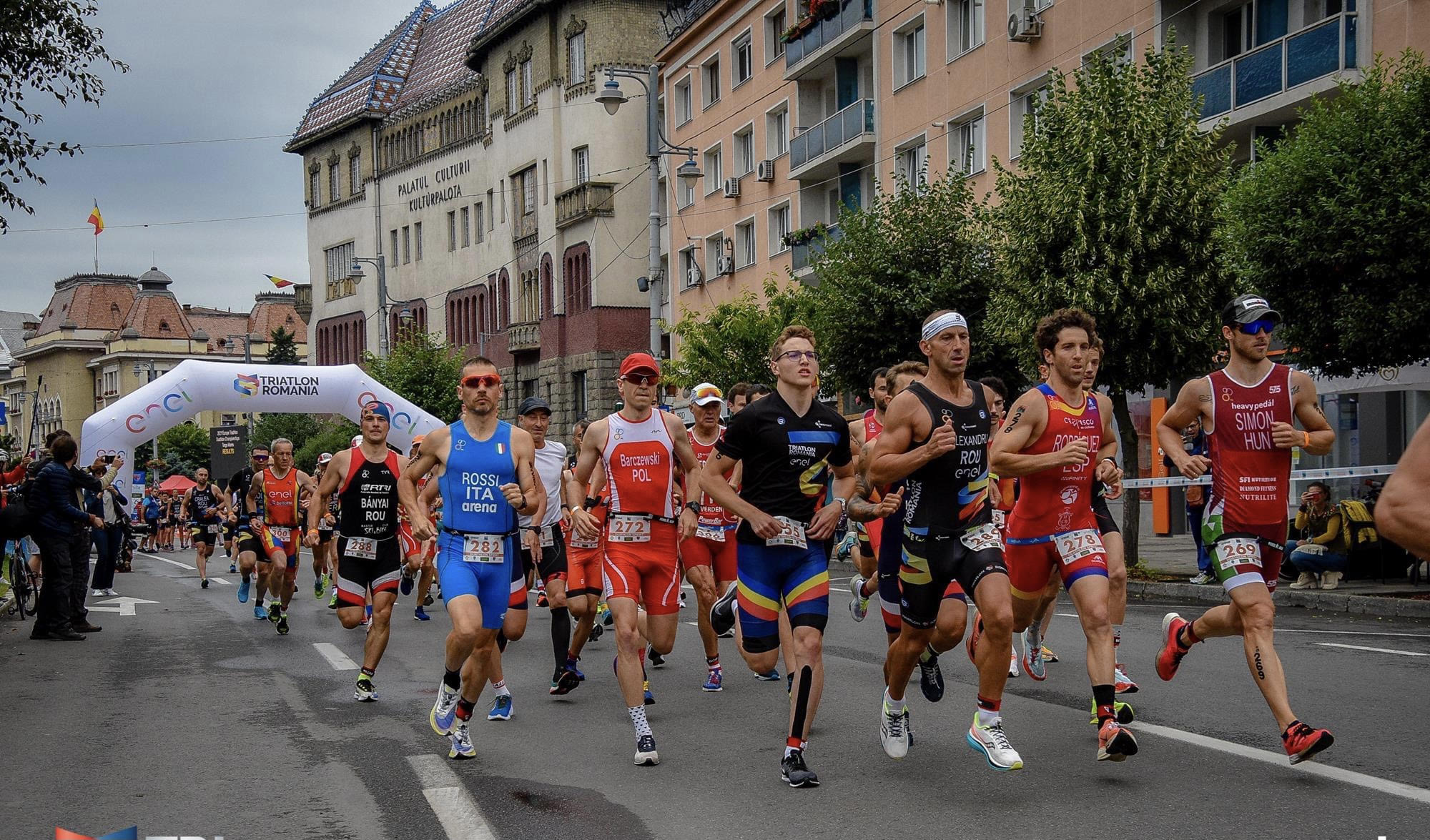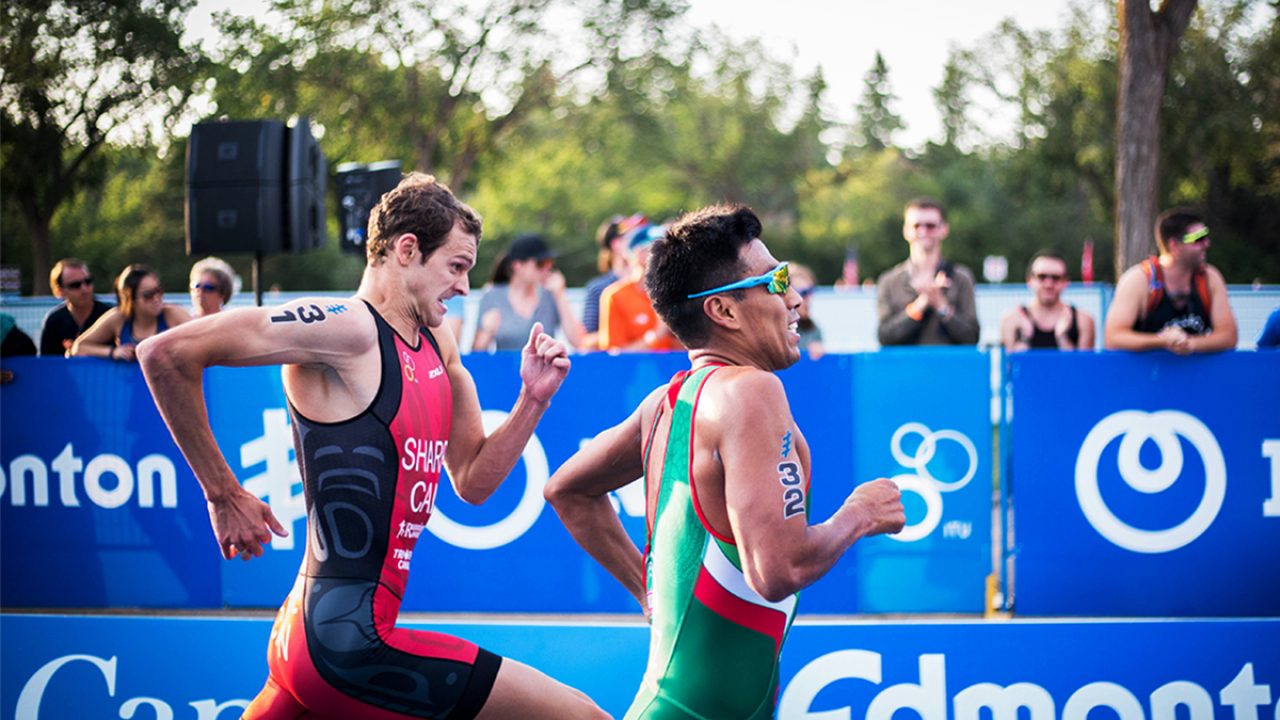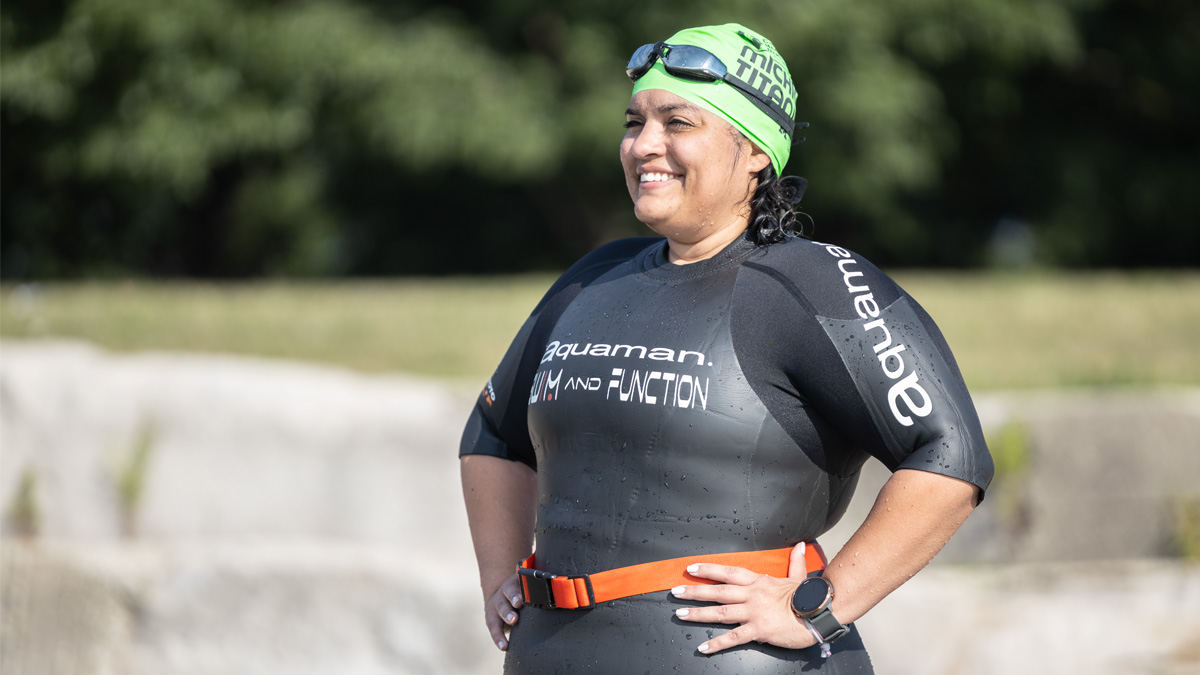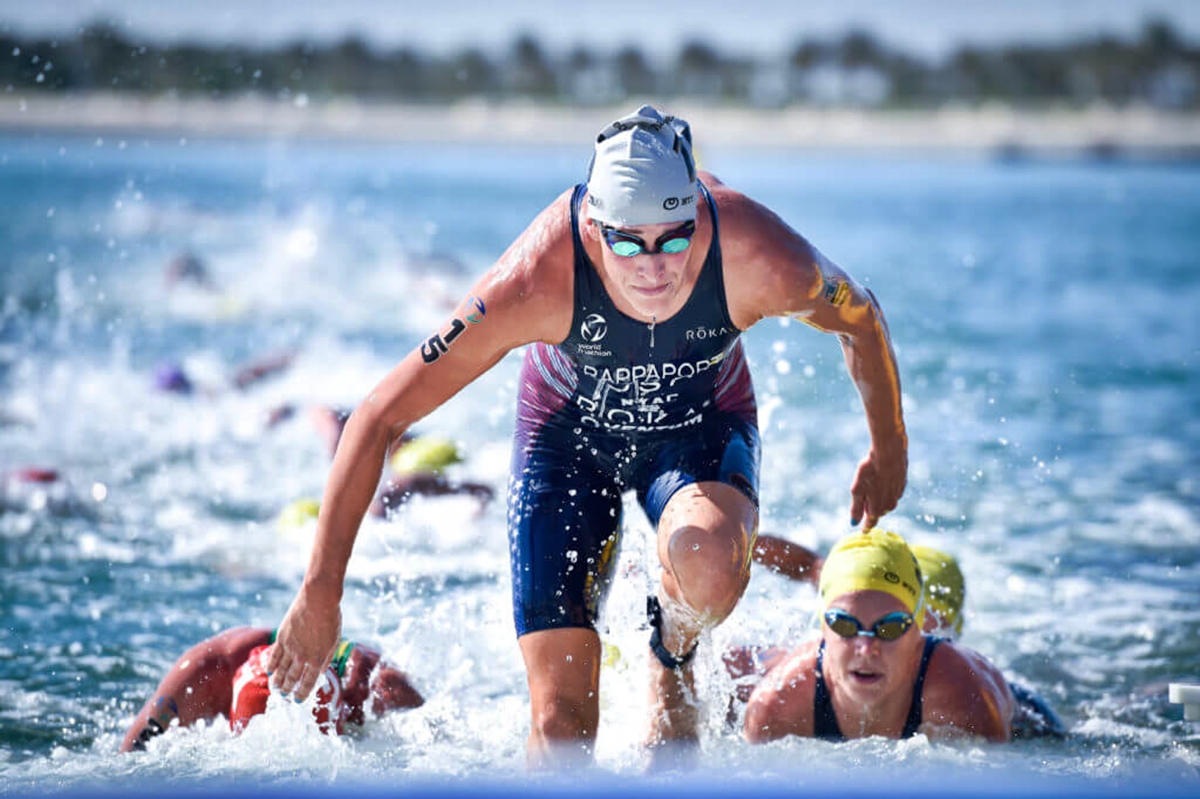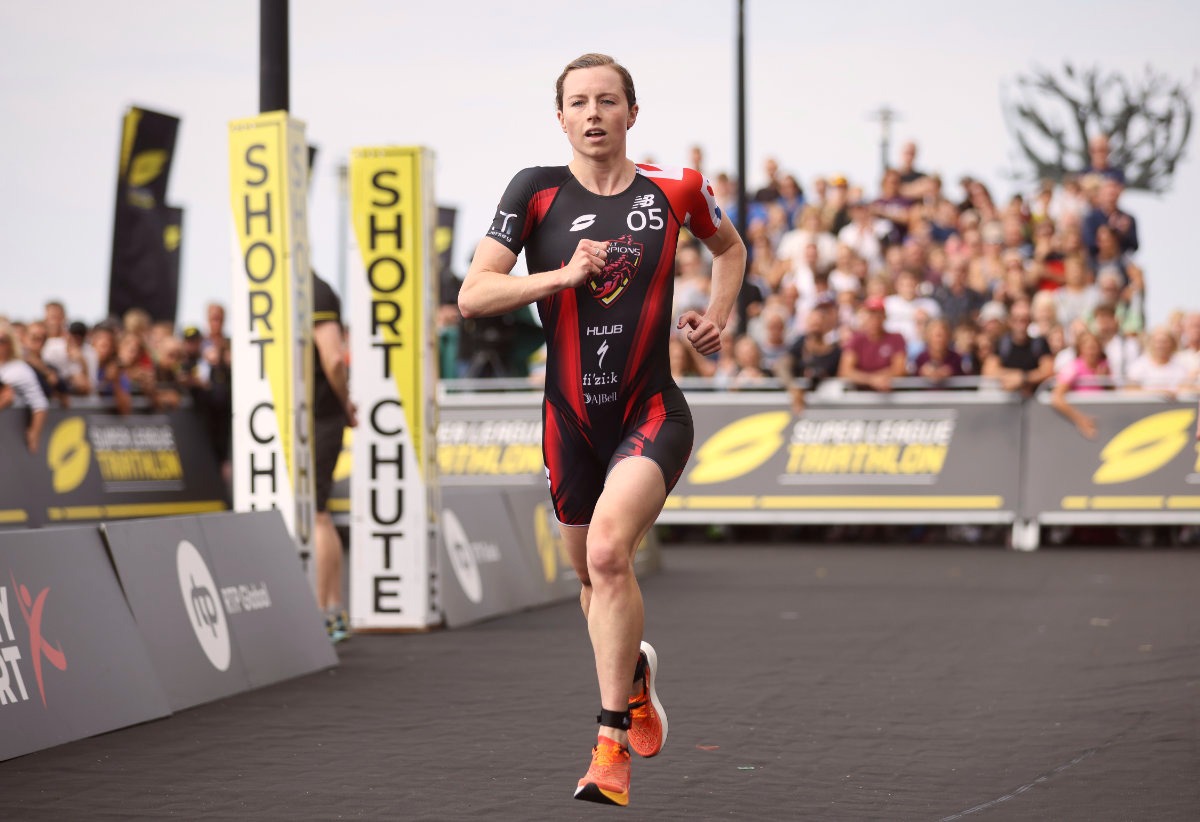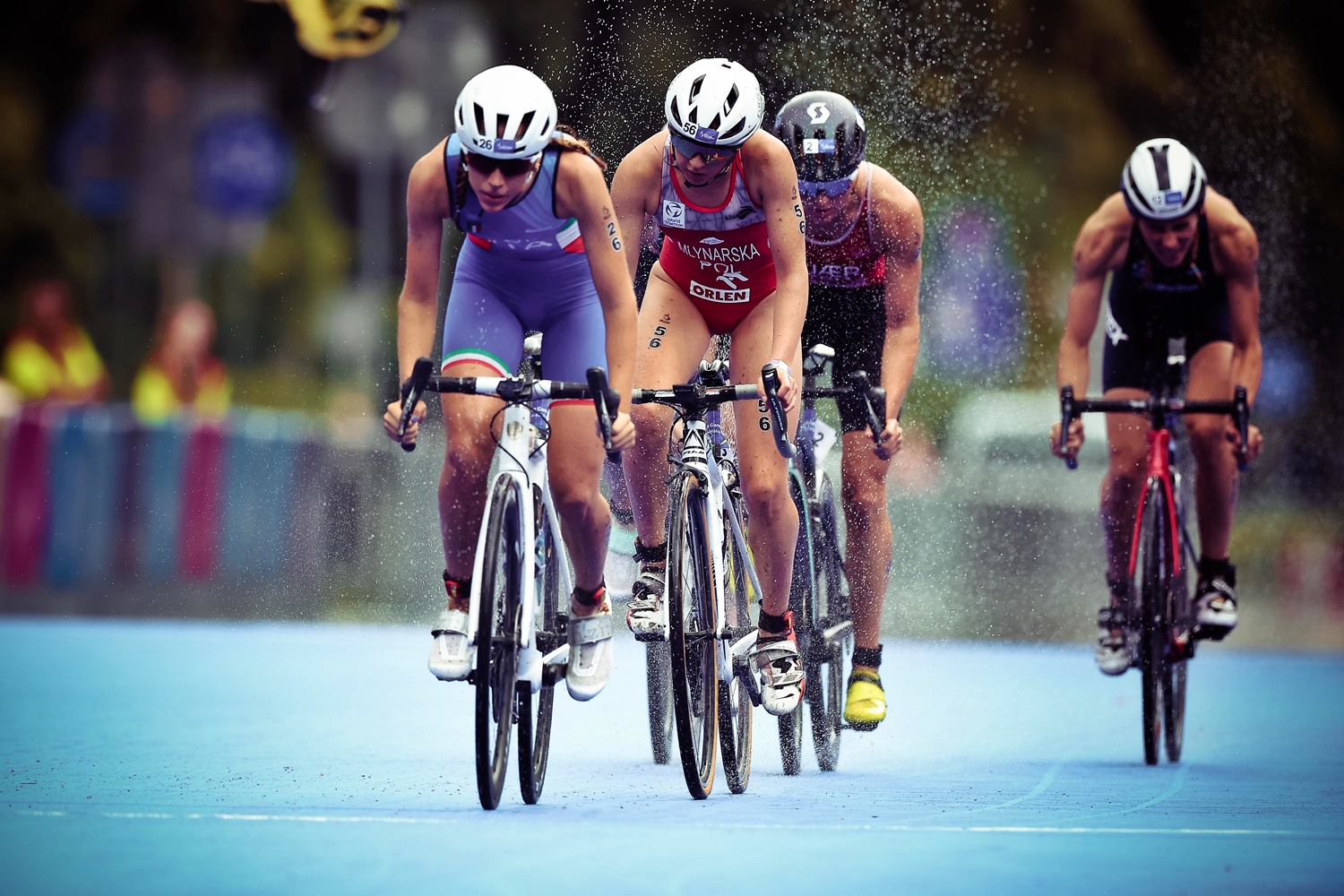

Featured
How To Organize A Triathlon Event
Published: August 12, 2023
Learn how to organize a featured triathlon event with our comprehensive guide. From planning to execution, we provide the step-by-step process for a successful event.
Introduction
Organizing a triathlon event can be an exciting and rewarding experience. Triathlons are multisport races that challenge participants to swim, bike, and run, pushing their physical and mental limits. Whether you’re a seasoned event planner or a passionate triathlete looking to give back to the sport, organizing a triathlon requires careful planning and attention to detail.
In this article, we will guide you through the process of organizing a successful triathlon event. From setting goals and securing funding to coordinating logistics and managing post-race activities, we will provide you with step-by-step instructions to help you plan and execute a memorable triathlon experience for participants and spectators alike.
Before we delve into the specifics of organizing a triathlon event, it is important to understand the unique challenges and considerations involved. Triathlons can vary in distance, ranging from sprint distances for beginners to Ironman distances for seasoned athletes. Each distance requires different course layouts, participant requirements, and logistical planning. As an event organizer, it is crucial to determine the type of triathlon event you want to host and tailor your planning accordingly.
Organizing a triathlon event is not only about creating a challenging and enjoyable race, but also about fostering a sense of community and camaraderie. Triathlons attract participants from diverse backgrounds and skill levels, and providing a welcoming and inclusive environment is essential. When organizing the event, be mindful of creating an atmosphere that promotes sportsmanship, encourages personal growth, and celebrates the achievements of all participants.
Now, let’s dive into the step-by-step process of organizing a triathlon event, starting with establishing the event goals and objectives.
Step 1: Establish the Event Goals and Objectives
Before diving into the details of organizing a triathlon event, it is essential to establish clear goals and objectives. By defining what you hope to achieve with the event, you can create a strategic plan that aligns with your vision.
Start by asking yourself some key questions. What is the purpose of the event? Are you aiming to create a competitive race for seasoned athletes, or do you want to provide a supportive environment for beginners to try their hand at triathlons? Are you organizing the event to raise funds for a particular cause or charity?
Once you have a clear understanding of your goals, it is important to outline specific objectives that will help you achieve them. These objectives can include metrics such as the number of participants, the amount of funds raised, or the level of community engagement.
For example, your goals might be to attract 500 participants, raise $10,000 for a local charity, and create a positive experience for athletes of all skill levels. These goals can then be broken down into objectives such as increasing marketing efforts to reach a wider audience, implementing fundraising initiatives, and offering training programs for beginners.
By establishing clear goals and objectives, you can build a solid foundation for your event planning. These goals will not only guide your decision-making throughout the organizing process but also allow you to measure the success of your event once it is completed.
Keep in mind that the goals and objectives you set should be realistic and achievable within your available resources. It is important to balance ambition with practicality to ensure that your event is both impactful and manageable.
Once you have established your event goals and objectives, it is time to move on to the next step: determining the event date and location. This decision will have a significant impact on the overall success of your triathlon event.
Step 2: Determine the Event Date and Location
Selecting the right event date and location is crucial for the success of your triathlon. These decisions will not only affect the availability and participation of athletes but also impact logistical considerations and the overall experience for both participants and spectators.
Firstly, consider the season and weather conditions. Triathlons are typically held during the spring and summer months, as this allows for pleasant outdoor conditions. However, it is important to research the climate of your desired location during these months to ensure that weather conditions are conducive to a safe and enjoyable event. Extreme weather conditions, such as excessive heat or storms, can pose risks for participants and may negatively impact the overall experience.
Furthermore, take into account any local events or holidays that could potentially clash with your chosen event date. Check community calendars, sporting events, and other major happenings to avoid scheduling conflicts that could impact participant turnout or availability of resources.
Next, consider the location. Look for areas that offer suitable venues for the swimming, biking, and running components of the triathlon. Ideally, the location should have a body of water for the swim portion, ample space for bike routes, and a designated route for the running segment. Additionally, the location should have adequate parking, restroom facilities, and space for post-race activities.
Research local authorities and regulations to ensure that your chosen location allows for triathlon events. Contact the necessary authorities to obtain permits and permissions required for hosting the event. It is important to note any restrictions or guidelines specified by the local government regarding noise levels, road closures, and other logistical considerations.
Consider the accessibility of the location for both participants and spectators. Choose a location that is convenient to reach, with well-connected transportation links. Additionally, assess the availability of accommodation options in the vicinity for participants traveling from out of town.
Lastly, consider the capacity of the location. Ensure that the venue can accommodate the expected number of participants, as well as any additional infrastructure required for amenities such as transition areas, aid stations, and spectator areas.
Once you have determined the event date and location, you can proceed to the next step: creating a budget and securing funding. This will help you outline the financial aspects required to bring your triathlon event to life.
Step 3: Create a Budget and Secure Funding
Creating a thorough budget and securing funding are essential steps in organizing a successful triathlon event. A well-planned budget will help you allocate resources effectively and ensure that your event remains financially sustainable.
Start by identifying all the expenses associated with organizing the triathlon. This includes costs such as permits and insurance, venue rental fees, race equipment and supplies, timing and scoring systems, marketing and promotion, staff and volunteer expenses, medical support, and post-race activities.
Research and gather quotes from suppliers and service providers to get an accurate estimate of the expenses involved. It is advisable to budget for contingencies to account for any unexpected costs that may arise during the planning and execution of the event.
Once you have determined the expenses, consider potential revenue streams to cover these costs. This can include participant registration fees, sponsorship from local businesses, fundraising initiatives, merchandise sales, and ticket sales for post-race activities.
When setting the participant registration fees, it is important to strike a balance between making the event affordable for participants and ensuring that the fees cover the costs of organizing the event. Research similar triathlon events in your area to get an idea of the pricing range and adjust accordingly based on your specific event requirements.
Seeking sponsorships is another effective way to secure funding for your triathlon event. Approach local businesses and organizations that align with the values and target audience of the event. Offer various sponsorship packages that provide exposure and promotional opportunities for sponsors in return for financial support.
In addition to monetary sponsorships, consider partnerships with companies that can provide in-kind support in the form of equipment, supplies, or services. This can help reduce costs and provide valuable resources for the event.
Explore fundraising initiatives to generate additional revenue. This can include organizing charity runs, online fundraising campaigns, or even partnering with local community groups for fundraising events. Engage with your target audience and promote the cause or charity your event supports to encourage donations.
Creating a detailed and realistic budget will not only help you track your expenses but also assist you in securing funding from various sources. Ensure that you keep a financial record throughout the planning process to maintain transparency and accountability.
Once you have a well-defined budget and secured the necessary funding, you can proceed to the next step: obtaining permits and insurance. These are crucial aspects of hosting a triathlon event and will help ensure compliance and safety.
Step 4: Obtain Permits and Insurance
Obtaining the necessary permits and insurance is a critical step in the process of organizing a triathlon event. It ensures compliance with local regulations, ensures the safety of participants and spectators, and protects you from potential liabilities.
Start by researching the specific permits required for hosting a triathlon in your chosen location. Contact the local government or relevant authorities to inquire about the permits needed and the process for obtaining them. Different areas may have different regulations and requirements, so it is important to familiarize yourself with the specific rules and guidelines that apply to your event.
Typically, you will need permits for road closures and traffic control, use of public spaces such as parks or beaches, and noise permits if your event involves amplified sound. It is essential to submit permit applications well in advance to allow sufficient time for review and approval.
In addition to permits, obtaining insurance coverage for your triathlon event is crucial. This helps protect you from financial and legal risks associated with accidents, injuries, or property damage that may occur during the event.
Contact reliable insurance providers specializing in sports events and discuss your specific coverage needs with them. Insurance coverage typically includes general liability insurance, which protects against claims from third parties, as well as participant accident insurance to provide coverage for athletes and volunteers participating in the event.
Ensure that the insurance policy you choose provides adequate coverage for the potential risks involved in the triathlon, including the swim, bike, and run segments. It is important to carefully review the policy terms and conditions, exclusions, and coverage limits to fully understand what is covered and what is not.
Additionally, require all participants to sign liability waivers during the registration process. These waivers inform participants of the inherent risks involved in the triathlon and obtain their agreement to waive any claims against the event organizers.
By obtaining the necessary permits and insurance coverage, you not only comply with legal requirements but also create a safe and secure environment for participants. Prioritizing safety and mitigating potential risks will ensure a successful and well-organized triathlon event.
Once you have obtained the permits and insurance, you can move forward with the next step: recruiting volunteers and staff. These individuals will play a crucial role in the smooth execution of your event.
Step 5: Recruit Volunteers and Staff
Recruiting a dedicated team of volunteers and staff is essential for the successful organization and execution of a triathlon event. These individuals will provide the necessary support and assistance to ensure that all aspects of the event run smoothly.
Start by identifying the key roles and responsibilities required for your triathlon event. This can include race marshals, registration staff, aid station volunteers, course marshals, timing and scoring personnel, medical support, and logistics coordinators.
Reach out to local sports clubs, community organizations, and schools to find volunteers who are interested in contributing to the event. Spread the word through your network, social media platforms, and local event listings to attract potential volunteers.
Clearly communicate the expectations and responsibilities associated with each role during the recruitment process. Provide volunteers with a detailed description of their tasks, the time commitment required, and any specific qualifications or training needed.
Consider hosting a volunteer orientation session to provide an overview of the event and answer any questions or concerns. This will help volunteers feel prepared and confident in their roles on the day of the event.
In addition to volunteers, it is important to recruit a core team of staff members who will oversee the planning and management of the event. This team can include an event director, logistics coordinator, marketing manager, registration coordinator, and finance manager.
Assign clear roles and responsibilities to each staff member and establish effective communication channels to ensure smooth collaboration. Regular team meetings and progress updates will help keep everyone aligned and informed of the event’s progress.
Show appreciation for both volunteers and staff by recognizing their efforts and thanking them for their time and commitment. This can be done through small gestures such as providing refreshments during meetings and on the event day, offering certificates or letters of appreciation, or hosting a post-event thank-you gathering.
Building a strong team of volunteers and staff who are passionate about triathlons and dedicated to creating a successful event will make a significant difference in the overall organization and experience of the triathlon.
Once you have recruited your team, it is time to move on to the next step: developing a marketing and promotion strategy. This will help attract participants and generate excitement for your triathlon event.
Step 6: Develop a Marketing and Promotion Strategy
A well-executed marketing and promotion strategy is essential for attracting participants and generating excitement for your triathlon event. By effectively reaching your target audience and creating buzz around the event, you can maximize participation and ensure its overall success.
Start by defining your target audience. Identify the demographics and characteristics of the individuals you want to attract to your triathlon event. Consider factors such as age, fitness level, geographic location, and previous triathlon experience.
Utilize various marketing channels to reach your target audience. This can include creating a dedicated event website that provides detailed information about the race, registration, and other event-related details. Use search engine optimization (SEO) techniques to improve your website’s visibility in online search results.
Embrace the power of social media platforms to engage with potential participants. Create official event pages or accounts on platforms such as Facebook, Instagram, and Twitter. Regularly post updates, training tips, participant spotlights, and behind-the-scenes content to build anticipation and encourage interaction.
Consider partnering with local fitness clubs, running groups, and triathlon communities to promote your event. Attend their training sessions or events to share information and distribute flyers or promotional materials.
Reach out to local media outlets such as newspapers, radio stations, and TV channels to secure coverage for your event. Submit press releases and organize media interviews to generate publicity. Highlight unique aspects of your event, such as a challenging course or a charitable cause, to capture media interest.
Utilize email marketing to communicate directly with potential participants. Collect email addresses through your event website or registration platform and send out regular newsletters with updates, training tips, and exclusive offers.
Consider offering referral incentives to encourage participants to bring along their friends and family members. This can be in the form of discounted registration or additional benefits for those who refer new participants.
Engage with the triathlon community by attending other triathlon events, conferences, or expos. Set up information booths or distribute promotional materials to raise awareness about your event among the target audience.
Collaborate with local businesses and sponsors to leverage their networks and reach a wider audience. Offer opportunities for cross-promotion or joint marketing efforts to mutually benefit both parties.
Monitoring and analyzing the effectiveness of your marketing efforts is crucial. Track registration numbers, website traffic, social media engagement, and other relevant metrics to assess the success of your strategies. Adjust your approach as necessary based on the insights gained.
Developing a comprehensive marketing and promotion strategy will help create awareness, build anticipation, and ultimately attract participants to your triathlon event. With a well-executed plan, you will maximize attendance and make your event a resounding success.
Once you have implemented your marketing strategy, it is time to move on to the next step: setting up the online registration process. This will streamline the participant registration and payment process, making it efficient and convenient for all those interested in participating in your event.
Step 7: Set Up Online Registration Process
Setting up an efficient and user-friendly online registration process is crucial for a smooth and seamless participant experience. With the advancement of technology, online registration has become the preferred method for participants to sign up for events like triathlons. Here are some essential steps to follow when setting up your online registration process.
Choose a reliable and user-friendly online registration platform. Look for a platform that allows you to customize the registration form to collect the necessary information from participants, such as personal details, emergency contacts, and any specific event requirements. The platform should also handle secure payment processing.
Design a clean and intuitive registration form. Keep it simple and easy to navigate, avoiding any unnecessary questions or steps that may deter participants. Include clear instructions and provide assistance options in case participants encounter any difficulties during the registration process.
Offer different registration options to cater to various participant needs. This could include options for individual participants, relay teams, or specific age groups. Consider offering early bird discounts or promotional codes as incentives for participants to register early.
Implement a tiered pricing structure if applicable. This encourages early registration and allows for flexibility in adjusting prices based on demand or event capacity.
Include an option for participants to purchase any additional merchandise, such as event t-shirts, caps, or medals. This can be done during the registration process or as add-ons after the participant has completed their registration.
Consider offering a waitlist feature for popular events that may reach capacity quickly. This allows interested participants to join a waitlist and be notified if spots become available.
Make sure to clearly communicate the registration deadlines and any refund or transfer policies. This helps manage participant expectations and avoids any potential confusion or disputes.
Provide a confirmation email to participants upon successful registration. This email should include all relevant event details, such as race day information, participant guidelines, and any additional steps participants need to take before the event.
Regularly monitor the registration process to ensure everything is running smoothly. Address any technical issues or participant queries promptly to maintain a positive registration experience.
Integrate your online registration platform with your event website and social media channels. This makes it easy for participants to find the registration link and share it with their networks.
After setting up the online registration process, regularly review the registration numbers and track the progress. Use this data to assess the success of your marketing efforts and make any necessary adjustments to boost participant numbers.
Setting up an efficient online registration process simplifies the participant experience, streamlines the data collection process, and allows for effective management of registrations. With a user-friendly online registration system in place, you can focus on other aspects of event planning and management.
The next step is to plan the race course and logistics, which is crucial for creating a safe and enjoyable experience for participants.
Step 8: Plan the Race Course and Logistics
Planning the race course and logistics is a critical step in organizing a triathlon event. It involves mapping out the route, ensuring participant safety, and coordinating logistics to create a smooth experience for all involved.
Start by carefully selecting the race course. Consider factors such as the desired distance for each segment (swim, bike, and run), the scenic appeal of the course, and any specific challenges or landmarks you want to include. Measure and mark the course accurately to ensure consistency and fairness for all participants.
When designing the swim course, take into account water conditions and safety considerations. Choose a location that provides adequate space for participants, taking into account both the start and finish points. Ensure that lifeguards or water safety personnel are present throughout the swim course to monitor participant safety.
For the bike course, prioritize participant safety and traffic flow. Identify roads with low traffic or those that can be temporarily closed for the event. Clearly mark the course with signage, traffic cones, and direction indicators to guide participants. Coordinate with local law enforcement or traffic control personnel to ensure the safety of both participants and motorists.
Plan the run course to provide participants with an enjoyable and challenging experience. Consider factors such as terrain, elevation, and participant flow. Provide clear course markers, aid stations, and medical support throughout the course.
In addition to the race course, coordinate logistics such as transition areas and aid stations. Designate clearly marked areas for participants to transition from one segment to another, ensuring that they have enough space and facilities to change gear and hydrate. Position aid stations strategically along the course, providing water, electrolytes, and snacks to keep participants fueled and hydrated.
Consider the safety and medical support needs of participants. Ensure that medical personnel are stationed throughout the race course and at the finish line. Communicate the locations of medical support and provide participants with contact information in case of emergencies.
Coordinate with local businesses and organizations to arrange for additional logistics, resources, and support services. This can include securing portable toilets, waste management services, and refreshments for post-race activities. Plan for parking areas to accommodate participants and spectators, and provide clear directions and maps to guide them to the event location.
Conduct a thorough safety assessment and risk management evaluation. Address any potential hazards or concerns, such as road conditions, weather conditions, or environmental factors. Develop contingency plans and communication protocols to handle unforeseen circumstances.
Communicate all race course and logistical details with participants through your event website, social media platforms, and pre-event emails. Provide maps, course descriptions, and any additional information they may need to prepare for the event.
By carefully planning the race course and logistics, you create a safe and enjoyable experience for participants. A well-organized event ensures that everyone can focus on the triathlon and make lasting memories.
The next step is to arrange for timing and scoring systems, which will provide accurate results and enhance the overall participant experience.
Step 9: Arrange for Timing and Scoring Systems
Timing and scoring systems are essential components of a triathlon event. They provide accurate and reliable results, ensuring fair competition and enhancing the overall participant experience. Arranging for timing and scoring systems involves selecting the right technology, coordinating with timing companies, and implementing efficient processes.
Start by researching and selecting a timing company that specializes in triathlon events. Look for a reputable company with experience in timing multisport races. Consider factors such as their track record, the technology they use, and the level of customer support they provide.
Communicate your event requirements to the timing company, including the specific distances and segments of the triathlon, any split times to be recorded, and the desired accuracy and timing granularity. Discuss any unique features of your event, such as wave starts or relay team timing, to ensure that the timing system can accommodate these needs.
Consider the technology options available, such as chip timing or manual timing with race officials. Chip timing is the most common method used in triathlons, where participants wear a timing chip that records their start, split, and finish times. Manual timing involves race officials manually recording participants’ bib numbers and times at various checkpoints.
Coordinate with the timing company to ensure the timely delivery and distribution of timing chips or bib numbers to participants. Provide clear instructions on how to properly wear and return the timing chip or bib number after the race.
Ensure that timing mats or manual timing stations are set up at appropriate locations along the race course to accurately record participants’ times. This includes the start line, transition areas, and the finish line. Verify that the timing equipment is in good working condition and that backup systems are available in case of any technical glitches.
Communicate the timing and scoring process to participants, including how their times will be recorded and how results will be disseminated. Make sure participants are aware of any penalties or disqualification rules related to timing and scoring.
In addition to overall timing, if your event includes multiple age groups or categories, arrange for the scoring system to accurately calculate and rank participants within each group. Collaborate with the timing company or develop a manual scoring system to manage these calculations effectively.
Work closely with the timing company to ensure the timely processing and publication of race results. Participants should be able to access their individual results online or through other means, such as a mobile app or email notifications. Coordinate with the timing company to promptly address any queries or discrepancies regarding the results.
Post-race, provide participants with printed or electronic certificates of completion or participation. Recognize the top finishers in each category with awards or medals, and organize an awards ceremony to celebrate their achievements.
By arranging for accurate timing and scoring systems, you enhance the overall participant experience and create a fair and competitive environment. Pay attention to the details and work closely with the timing company to ensure smooth operations and accurate results.
The next step is to organize the participant packet pick-up process, ensuring that participants receive all the necessary information and materials prior to the event.
Step 10: Organize Participant Packet Pick-up
Organizing a smooth and efficient participant packet pick-up process is crucial for ensuring that participants receive all the necessary information and materials prior to the triathlon event. This step involves preparing participant packets, coordinating logistics for pick-up, and providing a positive experience for participants.
Start by assembling participant packets that contain all the essential items participants will need for the triathlon. These may include race bibs with timing chips or bib numbers, swim caps, event t-shirts, race maps, instructions, and any additional items or promotional materials.
Clearly label each participant packet with unique identifiers, such as bib numbers or participant names, to ensure accuracy during distribution. Double-check the contents of each packet to avoid any missing or incorrect items.
Determine the location and schedule for the participant packet pick-up. Choose a convenient location, such as a local sports facility or expo center, that allows for easy access and adequate space to accommodate participants and staff. Consider setting up multiple pick-up stations to minimize wait times.
Communicate the pick-up schedule to participants well in advance through email, social media, and your event website. Provide clear instructions on the necessary documents or identification participants need to bring for identification and verification purposes.
Efficiently manage the participant packet pick-up process by implementing an organized system. Assign staff or volunteers to each pick-up station and ensure they are well-trained on the process and knowledgeable about event details. Consider using barcode scanners or electronic check-in systems to streamline the check-in process.
Establish designated areas for each component of the participant packet, making it easy for participants to collect their bibs, timing chips, t-shirts, and other materials. Clearly display signs or banners to direct participants to the appropriate stations.
Provide participants with any necessary information or updates during the packet pick-up process. Have a dedicated information booth or area staffed with knowledgeable personnel who can answer questions, provide event details, and address concerns.
Use this opportunity to create a positive and engaging experience for participants. Consider offering additional services or opportunities for participants to connect with sponsors or other vendors present at the packet pick-up location. Provide a festive atmosphere with music, decorations, and photo opportunities to create a memorable experience.
Ensure that you maintain the safety and security of the participant packets during the pick-up process. Implement measures to prevent theft or loss, such as secure storage rooms, surveillance cameras, or controlled access to the packet pick-up area.
Collect participant feedback during the pick-up process to identify areas for improvement in future events. Consider providing surveys or a feedback system to gather insights on the overall packet pick-up experience, including waiting times, staff friendliness, and the clarity of instructions provided.
By organizing an efficient and participant-friendly packet pick-up process, you set the tone for a positive participant experience leading up to the triathlon event. A smooth packet pick-up process helps participants feel prepared and excited for the upcoming challenge.
The next step is to coordinate event day operations, ensuring that all elements come together seamlessly to deliver a successful triathlon event.
Step 11: Coordinate Event Day Operations
Coordinating event day operations is a critical step in ensuring a smooth and successful triathlon. It involves managing various aspects, including participant check-in, course set-up, volunteer coordination, and post-event activities. By carefully coordinating these operations, you can create a seamless experience for participants and ensure the event runs efficiently.
Start by creating a detailed event day timeline that outlines the sequence of activities and their respective timelines. This will serve as a guide for you and your team to ensure that all tasks are completed on time.
Coordinate participant check-in and registration on event day. Arrange check-in stations where participants can pick up any remaining materials or submit any necessary waivers or documentation. Ensure there are enough staff or volunteers available to assist with check-in and answer any participant inquiries.
Work with race officials and timing company personnel to ensure the accurate timing of each segment, including the swim start, transition periods, and the finish line. Ensure that all timing equipment is set up correctly and tested prior to the start of the event.
Coordinate with local authorities to secure road closures or traffic control measures for the bike and run segments. Ensure that the race course is properly marked with signage, directional arrows, and any necessary safety precautions.
Coordinate the placement of aid stations along the race course. Make sure they are well-stocked with water, electrolytes, and snacks. Assign volunteers to each aid station and provide clear instructions on their roles and responsibilities.
Ensure that medical personnel are stationed at strategic points along the race course and at the finish line. Communicate with them regularly to address any medical emergencies or concerns that may arise during the event.
Coordinate with volunteers to ensure that each area of responsibility is manned. Assign volunteers to assist with participant guidance, transition area management, course marshaling, and other essential tasks. Conduct a pre-event briefing to go over roles, expectations, and safety procedures.
Communicate with participants and spectators throughout the event to provide updates, safety reminders, and any important announcements. Use public address systems, signage, and social media updates to keep everyone informed.
Coordinate post-race activities, such as refreshments, rest areas, and awards ceremonies. Create a designated area where participants can gather, relax, and celebrate their accomplishments. Distribute medals, certificates, or prizes to winners in each category.
Ensure that clean-up activities are carried out promptly once the event concludes. Coordinate with volunteers and staff to dismantle course markers, collect trash, and restore the event venue to its original state.
Throughout the event day, stay available and accessible to handle any unforeseen circumstances or emergencies. Maintain open lines of communication with staff, volunteers, participants, and local authorities to address any issues that may arise.
After the event, conduct a post-event evaluation to gather feedback from participants, volunteers, and staff. Use this feedback to improve future events and address any areas for improvement.
By effectively coordinating event day operations, you create a seamless and enjoyable experience for participants, volunteers, and spectators alike. A well-coordinated event ensures that everything runs smoothly and that participants can focus on giving their best performance in the triathlon.
The final step is to manage post-race activities and hold an awards ceremony to celebrate the accomplishments of participants.
Step 12: Manage Post-Race Activities and Awards Ceremony
Managing post-race activities and holding an awards ceremony is a vital step in wrapping up a triathlon event and celebrating the accomplishments of participants. This step involves coordinating post-race logistics, providing participant support, and organizing a memorable awards ceremony.
As participants cross the finish line, ensure that there are volunteers and staff members available to guide them towards rest areas or recovery zones. Set up areas where participants can cool down, rehydrate, and replenish their energy with light refreshments.
Communicate with medical personnel to provide any necessary post-race medical support. Address any injuries or health concerns promptly and ensure that participants receive appropriate attention and care.
Coordinate the collection of timing chips or bibs from participants. Set up designated areas where participants can return their timing chips or other borrowed items. This helps ensure the return of equipment and keeps track of inventory.
Coordinate the distribution of post-race amenities, such as finisher medals, t-shirts, or participation certificates. Ensure that there are adequate supplies available and that participants receive the correct items based on their completion of the triathlon.
Organize an awards ceremony to recognize and celebrate the top finishers in each category, including overall winners, age group winners, and relay team winners. Plan the timing and location of the ceremony to allow participants and spectators to join in the celebration.
Prepare and present awards or trophies to winners during the ceremony. Consider personalizing the awards with the event logo or the participants” names to make them even more meaningful. Provide a backdrop or stage for photo opportunities with the winners and sponsors.
Recognize the volunteers and staff members who contributed to the success of the event. Express appreciation for their hard work and dedication, as they played an integral role in ensuring the smooth operation of the triathlon.
Invite participants, volunteers, and sponsors to share their experiences and testimonials about the event. This can be done through social media, event websites, or a dedicated post-event feedback form. Use this feedback to improve future events and incorporate suggestions for further engagement.
Wrap up the event by expressing gratitude to all those involved, including participants, sponsors, volunteers, staff, and local authorities. Publish thank-you messages on social media, send emails, or publish a post-event newsletter to show appreciation for their support and participation.
Coordinate the cleanup and restoration of the event venue. Ensure that all equipment, signage, and waste are properly disposed of, leaving the area in its original condition. Collaborate with volunteers and staff members to complete this final task efficiently.
Reflect on the overall event and conduct a post-event evaluation. Review participant feedback, volunteer feedback, and any areas for improvement identified during the event. Use this evaluation to make adjustments and enhancements for future triathlon events.
Managing post-race activities and hosting an awards ceremony allows participants to celebrate their achievements and brings closure to the triathlon event. By providing support, recognition, and appreciation, you create a meaningful experience that participants will remember for years to come.
Conclusion
Organizing a triathlon event requires careful planning, attention to detail, and effective coordination. By following these twelve steps, you can ensure the successful execution of a memorable and engaging triathlon experience.
From establishing event goals and securing funding to coordinating event day operations and hosting an awards ceremony, each step plays a crucial role in the overall success of the event. By setting clear objectives, selecting suitable locations, and implementing efficient processes, you can create an event that attracts participants, engages the community, and leaves a lasting positive impact.
Remember to prioritize participant safety and well-being throughout the planning and execution stages. Obtain the necessary permits and insurance, coordinate with medical personnel, and implement safety measures along the race course. By creating a safe environment, participants can focus on giving their best performance and enjoying the triathlon experience.
Effective communication and engagement with participants, volunteers, sponsors, and the local community are also vital. Utilize online marketing strategies, engage with social media platforms, and collaborate with local businesses and organizations to spread the word about your event. Foster a sense of community and support for participants, encouraging both seasoned athletes and beginners to participate and showcase their skills.
Lastly, always strive for continuous improvement. Gather feedback from participants, volunteers, and stakeholders to identify areas for enhancement in future triathlon events. Assess the effectiveness of your marketing and promotion strategies, streamline registration procedures, and make adjustments to course design and logistics based on participant feedback.
Organizing a triathlon event can be challenging, but with careful planning and attention to detail, it can also be a rewarding experience. Seeing participants cross the finish line, witnessing the sense of accomplishment on their faces, and knowing that you played a part in creating that experience is truly fulfilling.
Remember, a well-organized triathlon event not only showcases the sport but also fosters a sense of camaraderie, promotes physical fitness, and creates a positive impact on the community. So, embrace the challenge, infuse your passion and creativity, and organize a successful and unforgettable triathlon event.
